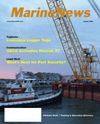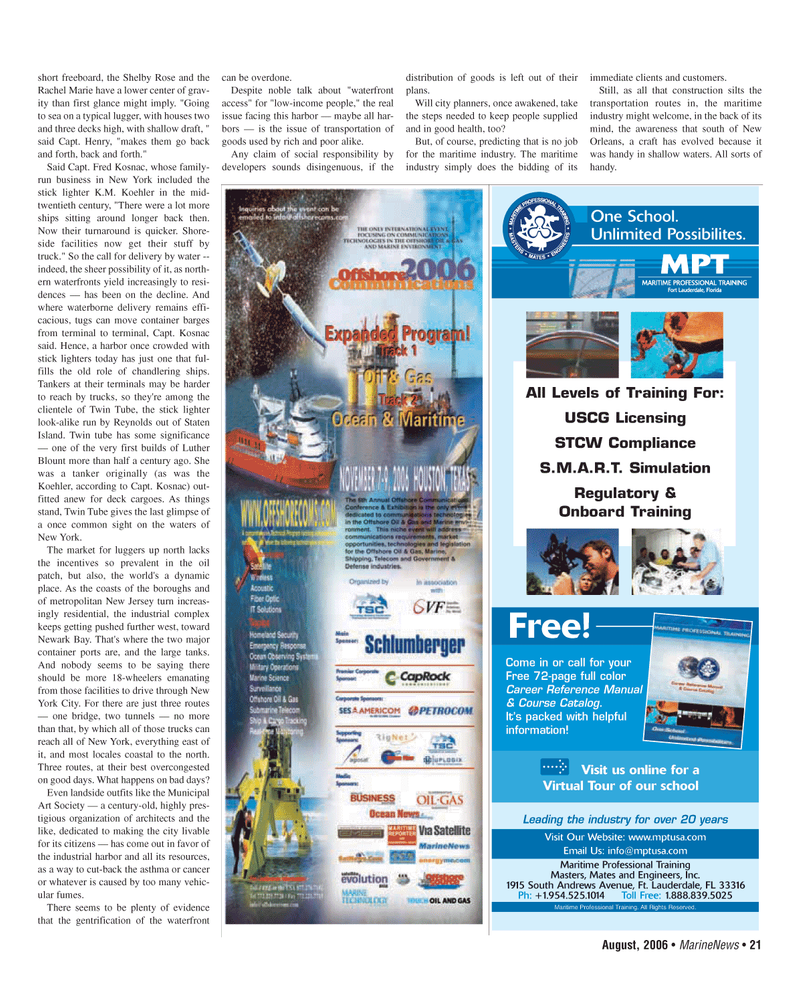
Page 21: of Marine News Magazine (August 2006)
AWO Edition: Inland & Offshore Waterways
Read this page in Pdf, Flash or Html5 edition of August 2006 Marine News Magazine
August, 2006 • MarineNews 21 short freeboard, the Shelby Rose and the
Rachel Marie have a lower center of grav- ity than first glance might imply. "Going to sea on a typical lugger, with houses two and three decks high, with shallow draft, " said Capt. Henry, "makes them go back and forth, back and forth."
Said Capt. Fred Kosnac, whose family- run business in New York included the stick lighter K.M. Koehler in the mid- twentieth century, "There were a lot more ships sitting around longer back then.
Now their turnaround is quicker. Shore- side facilities now get their stuff by truck." So the call for delivery by water -- indeed, the sheer possibility of it, as north- ern waterfronts yield increasingly to resi- dences — has been on the decline. And where waterborne delivery remains effi- cacious, tugs can move container barges from terminal to terminal, Capt. Kosnac said. Hence, a harbor once crowded with stick lighters today has just one that ful- fills the old role of chandlering ships.
Tankers at their terminals may be harder to reach by trucks, so they're among the clientele of Twin Tube, the stick lighter look-alike run by Reynolds out of Staten
Island. Twin tube has some significance — one of the very first builds of Luther
Blount more than half a century ago. She was a tanker originally (as was the
Koehler, according to Capt. Kosnac) out- fitted anew for deck cargoes. As things stand, Twin Tube gives the last glimpse of a once common sight on the waters of
New York.
The market for luggers up north lacks the incentives so prevalent in the oil patch, but also, the world's a dynamic place. As the coasts of the boroughs and of metropolitan New Jersey turn increas- ingly residential, the industrial complex keeps getting pushed further west, toward
Newark Bay. That's where the two major container ports are, and the large tanks.
And nobody seems to be saying there should be more 18-wheelers emanating from those facilities to drive through New
York City. For there are just three routes — one bridge, two tunnels — no more than that, by which all of those trucks can reach all of New York, everything east of it, and most locales coastal to the north.
Three routes, at their best overcongested on good days. What happens on bad days?
Even landside outfits like the Municipal
Art Society — a century-old, highly pres- tigious organization of architects and the like, dedicated to making the city livable for its citizens — has come out in favor of the industrial harbor and all its resources, as a way to cut-back the asthma or cancer or whatever is caused by too many vehic- ular fumes.
There seems to be plenty of evidence that the gentrification of the waterfront can be overdone.
Despite noble talk about "waterfront access" for "low-income people," the real issue facing this harbor — maybe all har- bors — is the issue of transportation of goods used by rich and poor alike.
Any claim of social responsibility by developers sounds disingenuous, if the distribution of goods is left out of their plans.
Will city planners, once awakened, take the steps needed to keep people supplied and in good health, too?
But, of course, predicting that is no job for the maritime industry. The maritime industry simply does the bidding of its immediate clients and customers.
Still, as all that construction silts the transportation routes in, the maritime industry might welcome, in the back of its mind, the awareness that south of New
Orleans, a craft has evolved because it was handy in shallow waters. All sorts of handy.
One School.
Unlimited Possibilites.
Maritime Professional Training
Masters, Mates and Engineers, Inc. 1915 South Andrews Avenue, Ft. Lauderdale, FL 33316
Ph: +1.954.525.1014 Toll Free: 1.888.839.5025
Maritime Professional Training. All Rights Reserved.
Visit Our Website: www.mptusa.com
Email Us: [email protected]
Leading the industry for over 20 years
Free!
Come in or call for your
Free 72-page full color
Career Reference Manual & Course Catalog.
It’s packed with helpful information!
Visit us online for a
Virtual Tour of our school
All Levels of Training For:
USCG Licensing
STCW Compliance
S.M.A.R.T. Simulation
Regulatory &
Onboard Training
AUGUST MN2006 3(17-24).qxd 8/3/2006 3:32 PM Page 21

 20
20

 22
22
